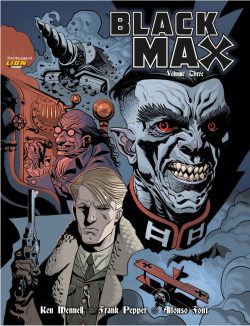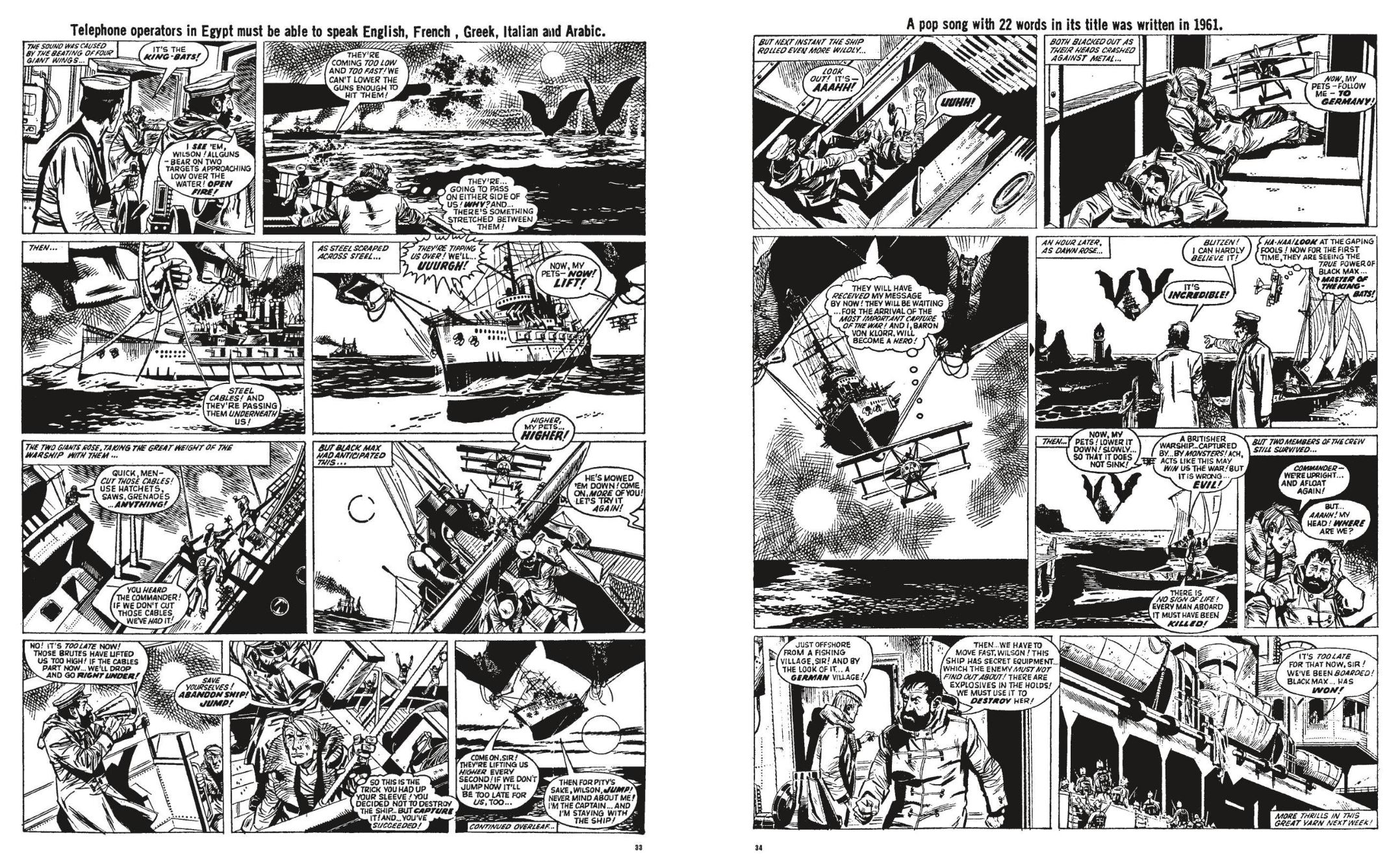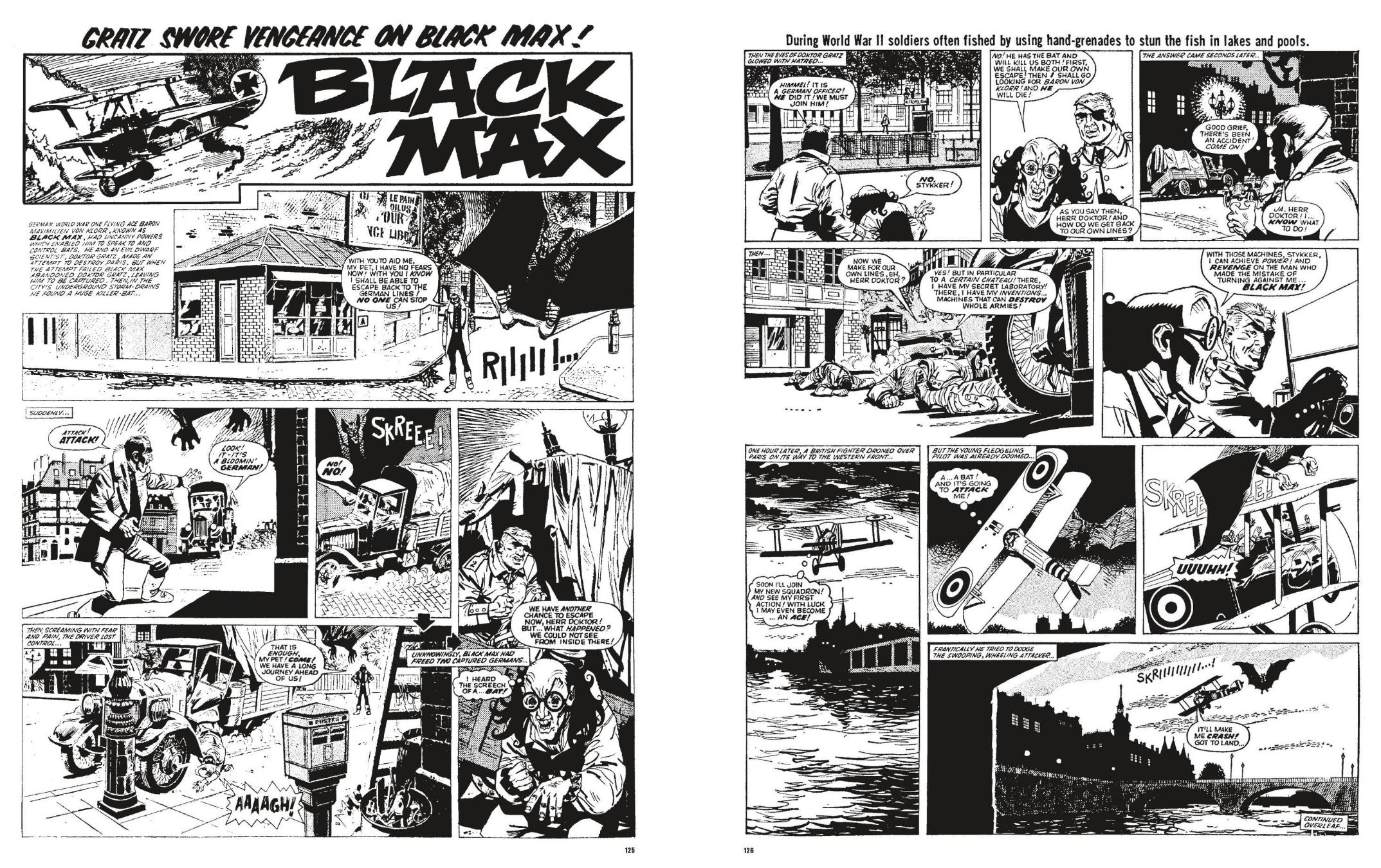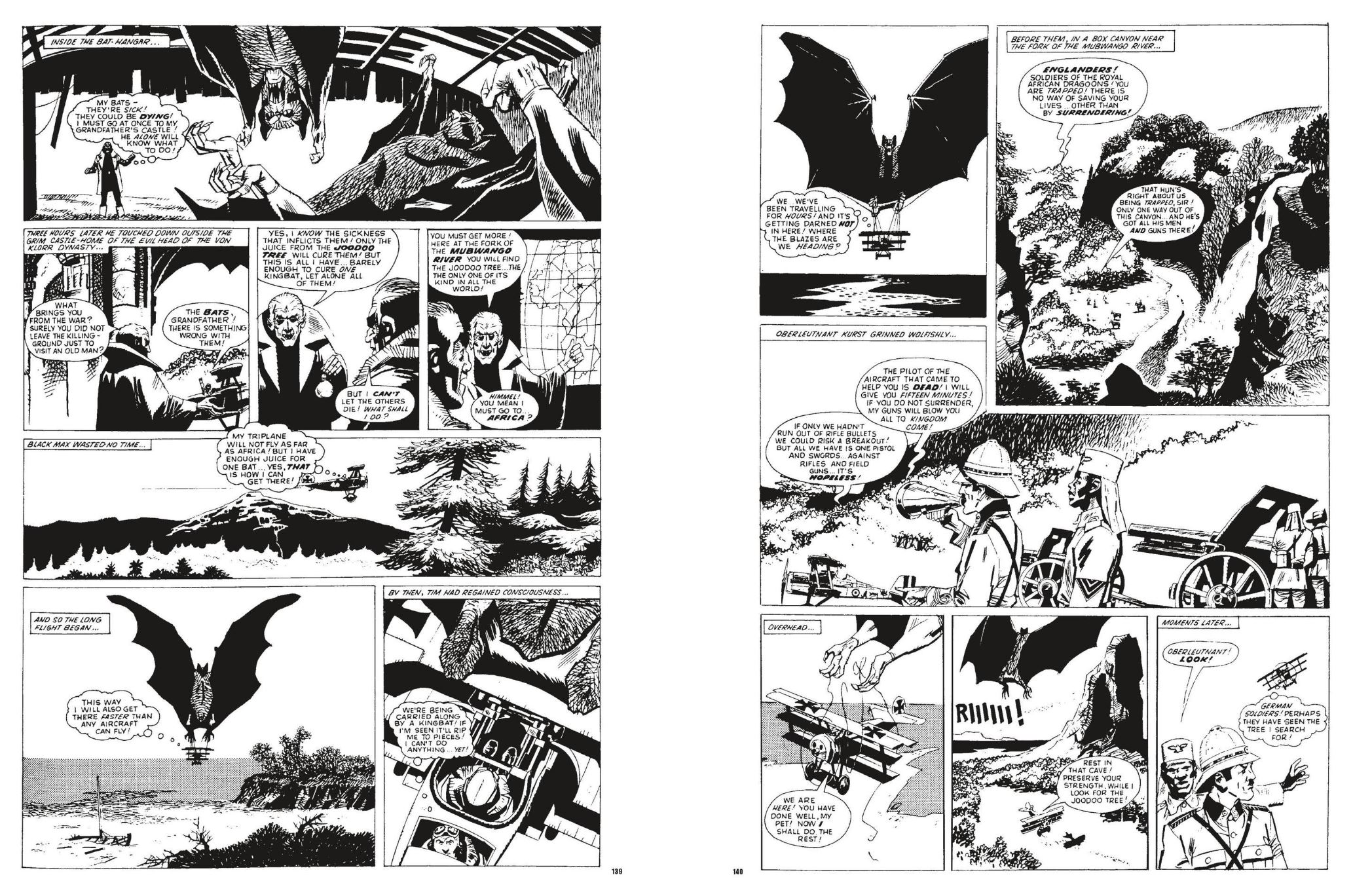

By Pat Mills & Joe Colquhoun & various (Rebellion)
ISBN: 978-1-78108-621-6 (TPB/Digital edition)
Win’s Christmas Gift Recommendation: Uncompromising and Unmissable… 10/10
This book includes Discriminatory Content included for dramatic effect.
The Great War officially ended today in 1918. I can’t tell you how glad I am that we got all that jingoism, racism, seductive superiority, addictive violence and nationalistic avarice out of our collective systems back then. It’s a much calmer, nicer world now, right?
Meanwhile, here’s more of the best story – bar none, in any medium – to translate those appalling, internationally insane, diplomatically deranged and pointlessly self-destructive days into scenarios we can accept and process, if not understand today. Charley’s War evocatively and emotionally depicts not only the mud and mire, military madness and mass mortality of that conflict, but also shared with the young and impressionable the social impact on the poor and the mighty who survived into the totally different world that followed. You must read it and the other two collected volumes. Message ends.
When Pat Mills & Joe Colquhoun began their tale of a patriotic working-class kid who broke the rules to proudly fight for his country just in time for the disastrous Somme campaign, I suspect they had, as always, the best of authorial intentions but no real idea that this time they were making comics history. The epochal feature was originally published in UK anthology Battle (AKA Battle Picture Weekly, Battle Action, etc.). A surprise hit, the serial proper launched in #200, eventually running from January 1979 to October 1986. It recounted, in heartrending, harrowing and often utterly surreal detail – and with amazing maturity and passion for a Boys’ Periodical – the life of an East End teen who grew up in the British Army reinforcements setting out to fight the Hun in 1916.
The strip contingent in this third stunning collection covers episodes #177-293 spanning October 2nd 1982-January 26th 1985, and closes the book on our lad’s wartime life, although the series did go on, as Charley went back to war when the Germans did in 1939…
One of the most powerful and influential characterisations of the oh-so-ironic “war to end all wars”, the comic feature was lovingly researched, lavishly limned and staggeringly authentic. Stories touched upon many diverse aspects of the conflict and even reveal the effects on the Home Front, all delivered with a devastatingly understated dry sense of horror and cruel injustice, albeit constantly leavened with gallows humour as trenchant as that legendarily “enjoyed” by the poor trench-bound “Tommies” of the time.
It all began with “the Story of a Soldier in World War One” which saw 16-year-old London Bus Company worker Charley Bourne lie about his age to illegally go “over there”. Once he got there, Bourne endured unending, horror on the muddy, blood-soaked battlefield of The Somme. He also experienced the callous ineptitude and toxic entitlement of the upper class idiots running the war, most of whom believed their own men were utterly expendable. Military life was alternately hard and unremittingly dull – except for brief bursts of manic aggression and strategic stupidity which ended so many lives. Closely following the recorded course of the war, Mills & Colquhoun placed young Charley in the Westshire Regiment and added a rapidly changing cast constantly whittled away by various modes of combat attrition.
The weekly hellscapes showed lesser known, far from glorious sides of the conflict readers in the 1980s had never seen in any other war comic. Each episode was punctuated by a narrative device of the simple lad’s letters to his family in “Blighty” whilst also cleverly utilising reproductions of cartoons and postcards of the period. For this closing edition most of those conceits were absent, leaving room for astounding action, increasingly surreal true incidents folded into Charley’s story and mounding indignation in every script Mills submitted…
With Boer War veteran Ole Bill Tozer as his mentor, Charley narrowly survived shelling, mudslides, digging details, gas attacks, the Trench Cat, rats, snipers, smug stupidity of commanding officers – although there are examples of good “brasshats” too – and the far too often insane absurdity of a modern soldier’s life.
On July 1st 1916 The Battle of the Somme began and Charley and his comrades were ordered “over the top”: expected to walk steadily into mortars and machine gun fire of entrenched German defenders. When his commanding officer was unable to stand the stupidity and ordered them to charge at a run, it saved the squad but ultimately led to Lt. Thomas being executed by firing squad. Charley and former musical hall ventriloquist Weeper Watkins refused to shoot him and were extensively punished by sadistic military policemen.
When Charley and his crooked brother-in-law Oliver Crawleigh were caught in the first tank battle in history and the dreadful German response, “Oiley” offered to pay Charley to either protect him or wound him in some minor way that would get safely back to Britain. When Charley refused, Oiley misused a tank to earn his “Blighty” passage home…
As previously stated, Charley’s War closely followed key historic events, using them as a skeleton to hang specific incidents upon, but this was not the strip’s only innovation. Highly detailed research concentrated more on character development than fighting – although there is so much shocking action – and declared to the readership (which at time of publication was categorically believed to be boys aged 9-13) that “our side” was as monstrous and stupid as “the Boche.” Mills also fully exercised his own political and creative agendas on the series and was constantly amazed at what he got away with and what seeming trivialities his editors pulled him up on (more fully expanded upon in the author’s informative ‘Strip Commentary’ which concludes this edition)…
No longer a fresh-faced innocent but a weary, battle-scarred veteran, Charley and the strip marched beyond the cataclysmic Somme Campaign into the conflict’s most bloody events. He was wounded again and sent home, albeit via torturous routes involving amnesia and U-Boat warfare. Mills & Colquhoun delivered acerbic social criticism as the recuperating lad experienced fresh horrors when the troop ship carrying him and Bill Tozer was torpedoed…
When the perilous North Sea odyssey at last brought Charley back to Silvertown in London’s West Ham, it was in the wake of a real-world catastrophic disaster wherein 50 tons of TNT detonated at a munitions factory, killing 70 workers and injuring a further 400.
No longer comfortable around civilians and with no stomach for the jingoistic nonsense of the stay-at-homes or the lies of boastful “war-hero” Oiley, Charley hung out in pubs with the Sarge, but was caught up in enemy air raids (giving the creators room to explore the enemy side via the zealous actions of devoted family man Kapitan Heinrich von Bergmann who led Zeppelins in night sorties against the hated English)…
London was under constant threat, not just from increasingly common aerial bombing raids which provoked mindless panic and destruction at the very heart of the British Empire, but also profiteering British industrialists and greedy munitions magnates who cared more for profit than the safety of their workers or even the victory of their homeland. During one raid Charley realised his mum was still in the local works as her boss refused to sound air raid evacuation alarms because he had profits and contracts to consider. His view of the land he was fighting for barely survived his valiant efforts to save her and took an even bigger hit when an unscrupulous army recruiter (earning bonuses for every volunteer signed up) attempted to entrap his underaged but battle-obsessed little brother Wilf…
The second volume opened with a bold experimental diversion as, in March 1917 readers experienced the testimony of a charismatic deserter. ‘Blue’s War’ was a story within a story with the strip’s titular character reduced to an avid and appalled listener…
Set in bombed-out London Streets where Red Caps hunted deserters, Charley learns even more horrific truths about “his side”. The military police are led by a pitiless, fanatical dying-of-wounds officer The Drag Man obsessively hounding a desperate character called Blue – based on real-world “Monocled Mutineer” Percy Toplis. The knife-wielding fugitive met Charley while looking for Oiley who has graduated from thievery and looting to selling fake papers and passage abroad to military absconders …
Disgusted, but unwilling to force anyone back into the war, Charley says nothing, and hears the hows & whys of Blue’s situation – a staggering tale of combat, cruelty, bravery and more army ineptitude. Blue is an Englishman who joined the French Foreign Legion. He served with the French Army and survived the hell of Verdun (longest battle of the WWI, lasting from February 21st to December 18th 1916), commandeering the strip for months to come.
Bourne’s grudging return to the Western Front in April 1917 sees him a seasoned veteran posted to the Salient before the Third Battle of Ypres and caught up in daily skirmishes, sudden deaths, simmering feuds among his comrades and even more arrant stupidity from the Brass. His job become more difficult when arrogant old enemy and ruthless aristocrat Captain Snell – who thinks the war a terrific lark – returns as commanding officer and appoints Charley his manservant/dogsbody…

Snell constantly undermines and crushes the spirit of the riffraff cannon fodder under his command and loves making their lives intolerable. By May the infantry have survived heat, the Third Battle of Ypres and – by August – Passchendaele. Snell’s unit is posted to an engineering detail where Bourne and co. endure backbreaking toil as “clay-kickers”, risking cave-ins, flood, gas, explosions and Germans above them digging into their tunnels: a year-long project undermining a vast ridge of solid rock that is the enemy artillery emplacement on the Messine Ridge. The goal was the biggest manmade explosion in history… thus far. In the build-up everyone dies, but at least Snell also goes to his infernal reward, with the pitiful survivors despatched to a brutal retraining centre, bringing Charley into contact with organised deserters and reuniting him with many lost comrades. In England Oiley facilitates war-mad Wilf Bourne’s enlistment years before he is legally eligible, and Charley spends agonised months trying to find out what happened to Wilf…
The mounting tensions, barbarous treatment and institutionalised class injustice at Etaples leads to a British army mutiny in September, triggering the most shameful moments of Charley’s life when he is forced to join another firing squad. The mutiny goes on for days, emptying stockades and allowing the settling of many old scores, but Charley’s war is even more complicated after encountering Blue again. Bourne is even more astonished by the Army’s capitulation to the mutineers’ terms, and totally unprepared for inevitable retaliations. In response he transfers to the most dangerous job in the army to expiate his guilt…
This final mostly monochrome collection commences with Charley’s utterly astounding experiences as a stretcher bearer, enduring insane rules of conduct and increased enemy action whilst ferrying wounded and the dead from the battlefields. In another experimental sortie the story even switches to “the future” to follow one of the Tommies Charley saves.
The creators wallow in bizarre historical accuracy and intriguing gallows humour but such heartfelt sentimental moments are truly breathtaking. Just keep telling yourself it’s a kids’ comics and see if you believe it…
Due to shocking injustices and standard army prejudices, Charley is soon a shooting soldier again, just in time for some of the most horrific tank and cavalry battles in history. He then becomes a sniper at the same time as a fanatical corporal named Adolf Hitler starts haunting the trenches in his sights, before the scene again shifts. Interlaced with Charley’s exploits, focus shifts week-by-week to encompass the air war as seen via the illicit adventures of under-age Wilf Bourne. An extended, crushing sequence follows as the dead end kid gives everything he has to achieve his dreams of being a fighter pilot…

It’s January 1918, and Charley is accused of shooting himself in a ploy to dodge combat. The storyline involves his surviving a court martial and meeting a nurse who will – after much misunderstanding – become his “missus”. As ever Mills seeks to demonstrate how this war and this strip affected the non-combatants involved. The sequence also sees the return of arch-nemesis Snell: released from an English mental asylum to lead his old regiment, because he’s apparently the “still-useful” side of “mad as a hatter”…
Another military sidestep brings Charley’s cousin Jack into the picture, allowing a powerful and memorable exploration of the sea war, particularly the disaster of Gallipoli and sinking of Scharnhorst, Gneisenau and Nürnberg at the first Battle of the Falkland Islands. Somehow, this overt political act of comics subversion and antiwar protest completely escaped editors in the months after the country experienced the second one…

At last surrendering to the forces of narrative, as the war staggered to a close, Charley was back at the front facing a desperate defeated enemy now fighting for their families’ lives. Gradually re-meeting and saying farewell to almost everyone he had met along the way Charley soldiered on to the end. The vicious fighting was aided by American troops. Some were brave, valiant and good comrades-in-oppression. Others were white…
In the end, the entire war comes down to a brutal personal grudge match with Snell, who was determined to kill the peasant who had ruined his life. It happened on November 11th 1918, but even though Bourne was triumphant, Snell had the posthumous last world. It also allowed the creators to extend the strip and shine a light on another shameful episode. Although most soldiers downed arms in November 1918, in Russia the conflict continued as Tsarist White Russians battled the growing Soviet power of Red Russians. Two dozen countries – England included – sent men and resources to fight communism at a distance. And thanks to Snell, poor Charley was one of them…
What he saw and did there would shape the rest of his life…

These compilations of Mills & Colquhoun’s comic strip condemnation of the Great War (and war-mongering and profiteering in general) reaffirm how then and now the feature was one of the most sophisticated and adult dramas ever seen in fiction, let alone the pages of a kids’ war comic. Lifted to dizzying heights of excellence by the phenomenal artwork of Joe Colquhoun – much of it in colour as the strip alternated between the prized cover spot and almost as prestigious centre-spread slot – these are masterpieces of subversive outrage. Included in this volume are restored colour sections (reproduced in monochrome for earlier collections but vibrantly hued here to vivid effect) plus Mills’ amazingly informative chapter notes and commentary on episodes 177-293. These were not the last strips to feature Charley Bourne or indeed Joe Colquhoun’s incredible art, but in Mills’ view were the true end of the dramatic arc as the soldier boy came home to his wife, and decades of poverty and unemployment… until WWII saw him return to fighting for a country that really didn’t care about its people, only prestige, status and entrenched power. The book concludes with the author’s incisive essay and pleas for more comics featuring ‘A Working Class Hero’…
Charley’s War is a highpoint and benchmark in the narrative examination of the Great War in any artistic medium and exists as a shining example of how good “Children’s Comics” can be. It is also one of the most powerful pieces of fiction ever produced for readers of any age. I know of no anti-war story that is as gripping, as engaging and as engrossing, no strip that so successfully transcends mass-market origins and popular culture roots to become a landmark of fictive brilliance. I’d bribe Ministers to get these wonderful books onto the National Curriculum. We can only thank our lucky stars no Hollywood hack has made it a “blockbuster” inescapably undercutting the tangibility of the “heroes” whilst debasing the message. There is nothing quite like it and you are diminished by not reading it.
© 1979, 1980, 1981, 1982, 1983, 1984, 1985 & 2018 Rebellion Publishing Ltd. All rights reserved. Charley’s War is ™ & © Rebellion Publishing Ltd. All Rights Reserved.























